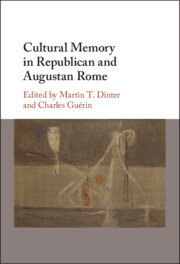Book contents
- Cultural Memory in Republican and Augustan Rome
- Cultural Memory in Republican and Augustan Rome
- Copyright page
- Contents
- Figures
- Contributors
- Acknowledgements
- Chapter 1 Introduction: What is Cultural Memory?
- Part I Writing Cultural Memory
- Part II Politicising Cultural Memory
- Part III Building Cultural Memory
- Part IV Locating Cultural Memory
- Chapter 19 Exchanging Memories: Coins, Conquest, and Resistance in Roman Iberia
- Chapter 20 Cicero and Clodius Together: The Porta Romana Inscriptions of Roman Ostia As Cultural Memory
- Chapter 21 Augustan Cultural Memories in Roman Athens
- Chapter 22 Different Pasts: Using and Constructing Memory in Augustan Carthage and Corinth
- Bibliography
- Index Locorum
- Index
Chapter 19 - Exchanging Memories: Coins, Conquest, and Resistance in Roman Iberia
from Part IV - Locating Cultural Memory
Published online by Cambridge University Press: 27 April 2023
- Cultural Memory in Republican and Augustan Rome
- Cultural Memory in Republican and Augustan Rome
- Copyright page
- Contents
- Figures
- Contributors
- Acknowledgements
- Chapter 1 Introduction: What is Cultural Memory?
- Part I Writing Cultural Memory
- Part II Politicising Cultural Memory
- Part III Building Cultural Memory
- Part IV Locating Cultural Memory
- Chapter 19 Exchanging Memories: Coins, Conquest, and Resistance in Roman Iberia
- Chapter 20 Cicero and Clodius Together: The Porta Romana Inscriptions of Roman Ostia As Cultural Memory
- Chapter 21 Augustan Cultural Memories in Roman Athens
- Chapter 22 Different Pasts: Using and Constructing Memory in Augustan Carthage and Corinth
- Bibliography
- Index Locorum
- Index
Summary
In 211 BC, the Romans were embroiled in a multi-front war with the great Carthaginian general Hannibal, and despite surviving the disastrous battles of the early years of the war, the Romans continued to face significant setbacks. In the Iberian Peninsula that year, the last-minute defection of Rome’s Celtiberian allies led to the deaths in battle of Publius and Gnaeus Cornelius Scipio, along with many of their soldiers. This was a disastrous blow to Rome’s war with Carthage, since the campaign in Iberia had been the only successful front in recent years.1 It is perhaps surprising, then, that the Romans minted a coin in Iberia that year that was stamped with symbols of Roman victory (Figure 19.1). The coin shows the Roman god Jupiter on the obverse (front) wearing a laurel wreath on his head, and the goddess Victory standing before a Roman trophy on the reverse (back).
- Type
- Chapter
- Information
- Cultural Memory in Republican and Augustan Rome , pp. 333 - 354Publisher: Cambridge University PressPrint publication year: 2023

